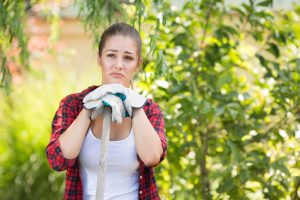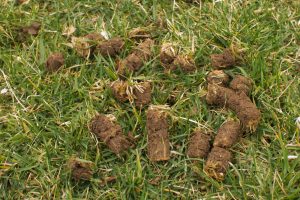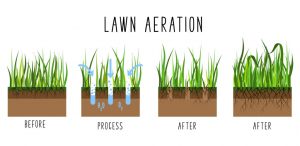
Have you been working hard on your lawn this year, fertilizing it to make it a lush green and applying weed control to get rid of those pesky weeds. Monitoring it closely to make sure it is properly watered. Mowing regularly at the recommended height while trying to mow in a different direction each week (as you’ve heard should be done but never seem to have the time to do). And it still doesn’t look as good as you hoped or imagined it would?

Or maybe it doesn’t look as good as your neighbor’s lawn and you never see them in their backyard measuring the lawn to make sure they’re cutting it at the proper height or hand pulling those nasty dandelions that just won’t seem to go away?!
We hear you. This can be very frustrating. And it could be due to a number of reasons … lack of heat and sun to make your lawn grow, hail, rainy weather, cool nights. Unfortunately the weather is one thing we can’t change or control. And our crazy Alberta weather provides some great stories to share at the water cooler and around the campfire!
If your lawn doesn’t look as healthy, green and lush as you hoped or imagined it would, then you may want to try Core Aeration, if you haven’t had this done recently.
Reasons Why Your Lawn May Become Compacted
Aeration is handy when your lawn becomes compacted. When your lawn becomes compacted it can’t breathe.
Your lawn can become compacted for a variety of reasons:
- children playing on the lawn
- animals running in the yard
- foot traffic ie lawn is used as a pathway to exit the yard or access a garden shed
- clay soil
- parking vehicles on the lawn
Signs That Your Lawn Is Compacted
- Water pools on your lawn after watering or after a heavy rain. When soil is compacted water has a hard time soaking into the ground and instead pools.
- Your lawn is brown. When soil is compacted water has a hard time soaking into the ground to reach the roots, your grass doesn’t get enough water and turns brown.
- Your lawn feels spongy.
- Your lawn has thick hatch.
- Your lawn has areas where the grass is thin, grows poorly or even bare soil.
- The ground is so hard that you have a difficult time digging into the soil with a shovel.
- If you have trees around compacted soil, you may find that they are in poor health.
Compaction & Its Consequences
Compacted soil prevents water and air from reaching the roots of the grass in your lawn, starving your lawn of the nutrients it requires in order to be healthy.
Now that we have identified some of the causes of compaction, signs your lawn is compacted, let’s talk about aeration – what is it, when is the best time to do it and how often does it need to be done in order to avoid the problem returning.
What is Core Aeration?
Core Aeration removes small plugs of thatch and soil from the lawn, allowing your lawn to breathe. These plugs are then left on your lawn to decompose, providing more nutrients to your lawn, with the holes filling in within a few weeks, depending on time of year, weather and soil conditions.

Core Aeration is recommended once per year, in the Spring or Fall.
If aerating in the spring, to best prevent weeds with core aeration, you will need to aerate before spring weeds start to germinate. In the spring, if you see dandelions appearing in your lawn, it is too late to aerate.
Fall aeration should be done after temperatures have cooled off. Fall aeration preps your grass for a thicker and greener lawn in the spring.
Benefits of Core Aeration
Benefits of Core Aeration include:
- Improves air exchange
- Enhances uptake of water and fertilizer by the soil
- Reduces water run-off and puddling
- Leaves room for root growth
- Creates stronger turfgrass roots
- Reduces soil compaction
- Increases tolerance to stress brought on by heat and drought
- Enhances thatch breakdown by increasing the activity of soil microorganisms
- Improves water and nutrient movement into the soil

At Earth Smart Property Solutions we use a core aerator machine and provide this service in the spring and fall in Calgary, Red Deer and close surrounding areas. Click here to learn more about this service.
Please contact us if you have any questions about your lawn and to discuss whether it could benefit from this service or to request a quote.
Please note that newly seeded or sodded lawns should not be aerated in the first year.

3 Comments